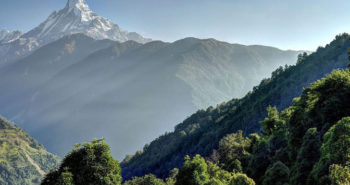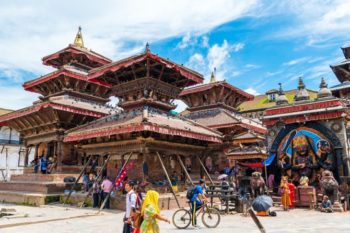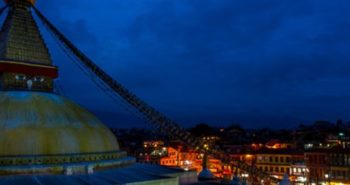When is the best time to trek the Manaslu Circuit?
Spring and Autumn offer the ideal combination of pleasant weather, stunning scenery, comfortable trekking conditions, and adequate resources, making them the best times to experience the Manaslu Circuit Trek. Here are several reasons why you want to choose Spring(March to May) and Autumn(September to November) to trek the Manaslu Circuit.
Favorable weather conditions: Both seasons offer clear skies, stable weather patterns, and comfortable temperatures. This makes for pleasant trekking conditions with minimal risk of bad weather interfering with your journey.
Clear mountain views: The lack of precipitation and mist during these seasons allows for stunning panoramic views of the Himalayas, including Mount Manaslu itself. This is a major draw for trekkers who want to experience the full beauty of the region.
Lush landscapes: Spring boasts vibrant wildflowers and rhododendrons in bloom, while autumn showcases the colorful foliage of the lower valleys. This adds a unique and picturesque element to the trek.
Pleasant temperatures: Both spring and autumn offer moderate temperatures that are neither too hot nor too cold. This makes the trek more enjoyable and less physically demanding.
Open teahouses: All teahouses along the route are open and well-stocked during these peak seasons, ensuring comfortable lodging and readily available food and supplies.
Longer days: Spring and autumn offer longer daylight hours, giving you more time to trek each day and explore the surrounding areas.
Reduced risk of landslides: While the monsoon season brings lush greenery, it also increases the risk of landslides. Spring and autumn offer a safer trekking experience with less chance of encountering these hazards.
While each season offers its unique charm, winter trekking on the Manaslu Circuit presents a special challenge. The snow-covered landscape becomes a wonderland, but crossing Larke Pass under heavy snowfall demands skill and experience. While most teahouses in Dharmasala close, Magical Nepal’s expert guides, equipped with knowledge of winter conditions and trusted local connections, are prepared to navigate these challenges, including opening teahouses and preparing food. This ensures a thrilling and unforgettable winter adventure for the intrepid trekker. Foods are limited in the winter season.
The lush green beauty of the rainy season comes with its own set of challenges. Landslides can block trails, forcing detours or even turning back. Rain can make trekking unpleasant and limit visibility, obscuring the majestic Himalayas for most of the day. While views may be scarce, the vibrant green landscape offers its unique charm for the adventurous trekker who embraces the unpredictable nature of this season.
Let’s delve into the unique offerings and challenges of spring, summer, autumn, and even winter. You will discover the landscapes, weather, and experiences that each season holds, helping you choose the perfect time for your Manaslu adventure.
1. Late December to Early March
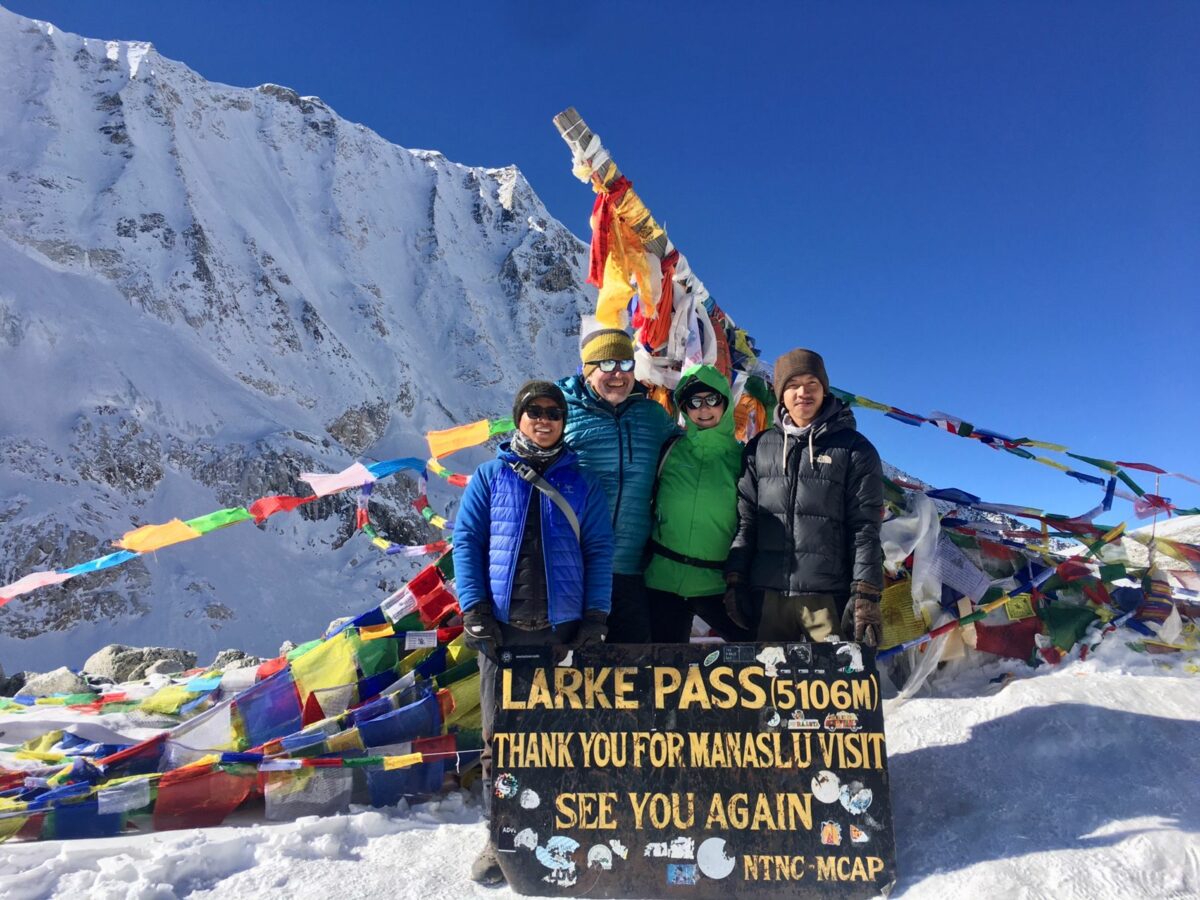
The Manaslu Trek begins at Macha Khola, nestled at 800 meters (approximately 2,625 feet) above sea level. The lower section of the trail basks in warmth, making daytime trekking comfortable even in winter. The initial trail winds through charming villages, subtropical forests, and cascading rivers. Winter paints the landscape in vibrant hues. The warmth of the sun during the day makes for comfortable trekking, while the crisp mountain air invigorates your senses.
The cold you encounter is offset by the breathtaking sight of frozen waterfalls and rivers adding a touch of magic to the landscape. However, above Namrung, the path transforms into snow-covered terrain, and venturing further to Manaslu Base Camp is deemed too risky during the winter season.
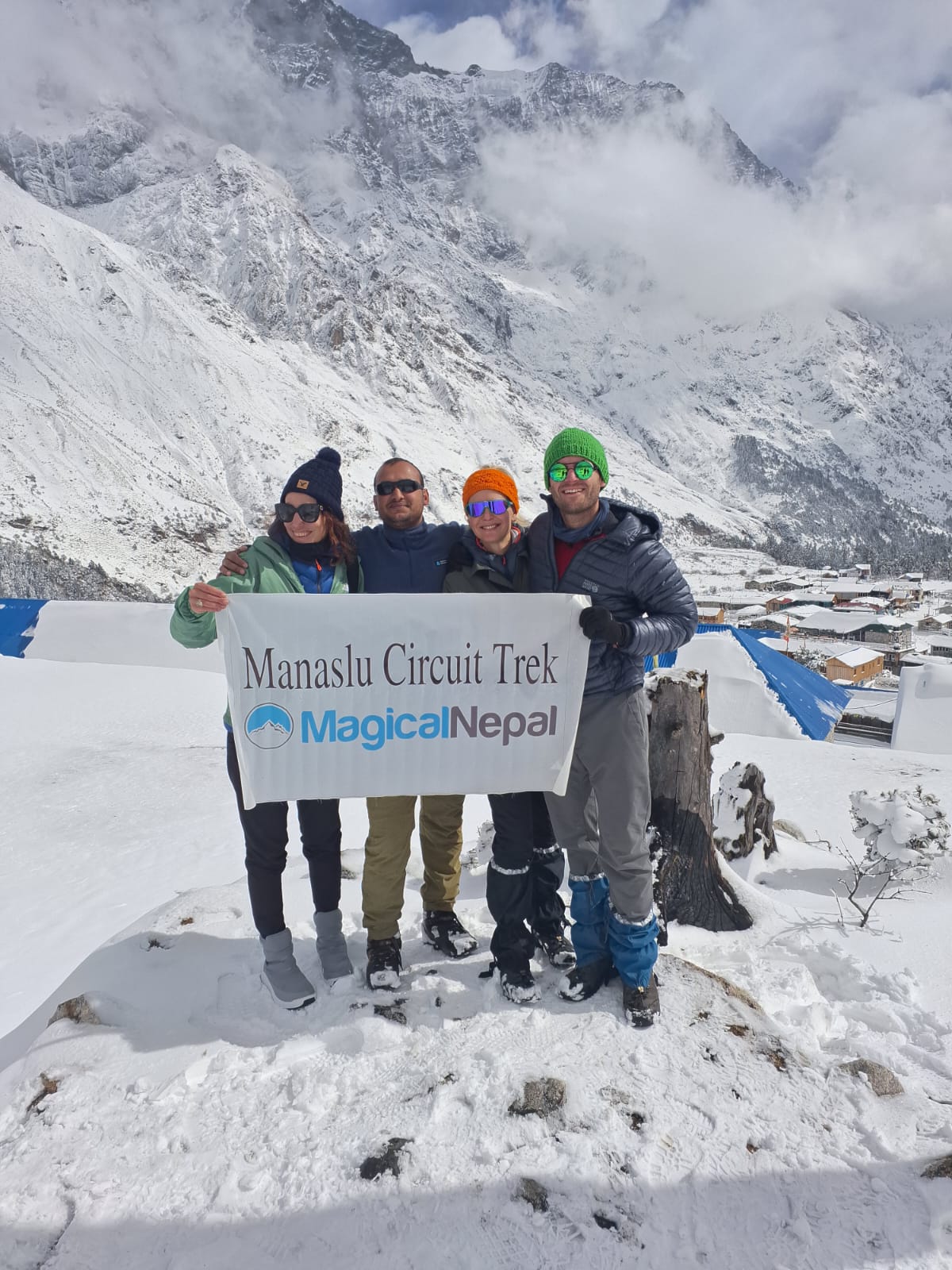
As you ascend above Namrung, the landscape undergoes a dramatic transformation. Towering waterfalls stand frozen in time, their icy sculptures shimmering in the sunlight. Rivers become glistening pathways of ice, adding a touch of magic to the environment. While the beauty is undeniable, these frozen landscapes require caution and careful navigation.
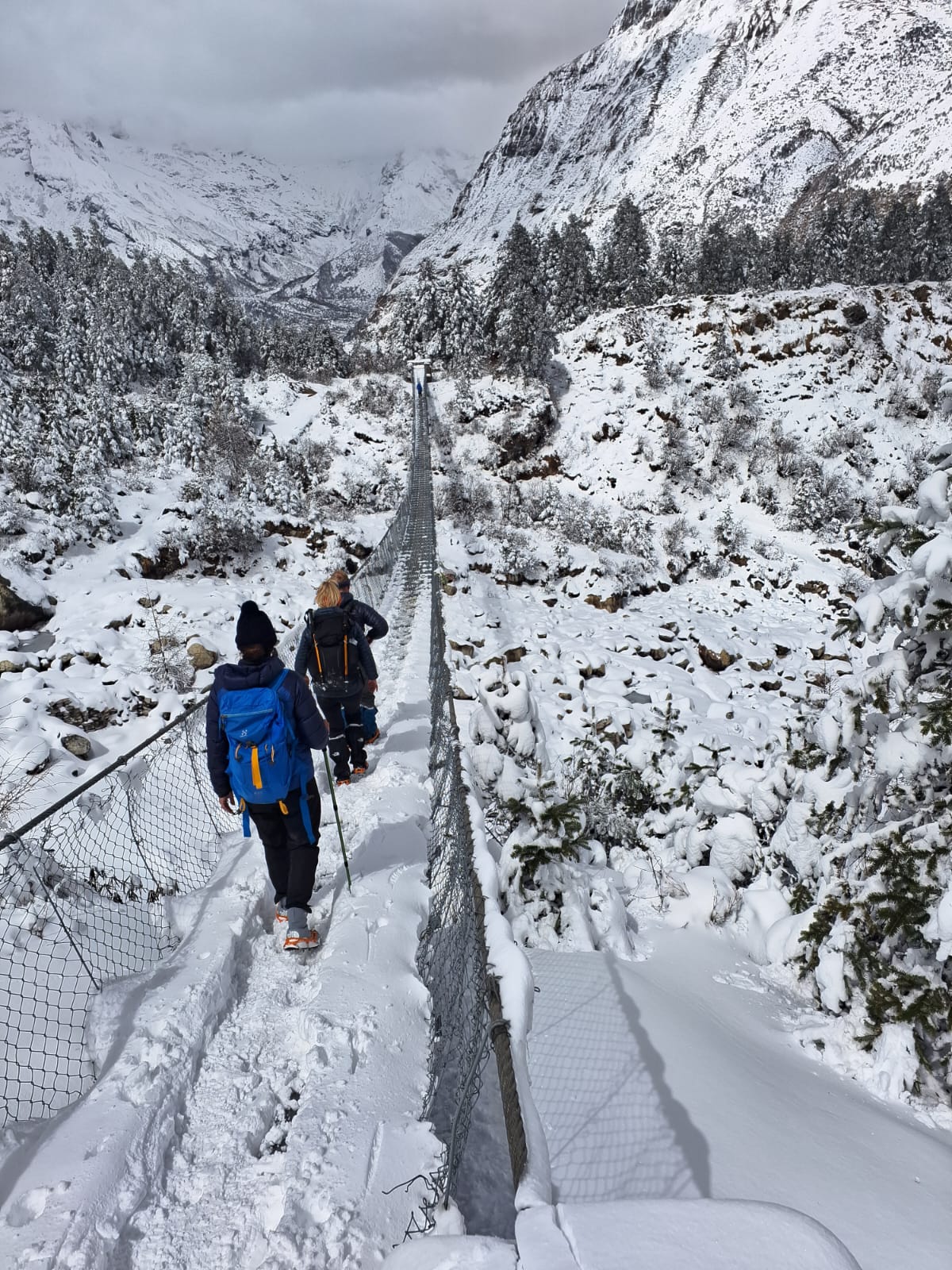
With the Dharmasala lodge closed, crossing Larke Pass becomes a one-day challenge, requiring a minimum of 12-13 hours of endurance. While teahouses remain closed, our experienced guides prepare, carry keys, and cook delicious meals for our clients to ensure a comfortable and fulfilling trek. This high-altitude pass, standing at 5,160 meters (16,930 feet), demands physical endurance and mental fortitude. Our experienced guides, equipped with expert knowledge and winter gear, will lead you through this challenging terrain, ensuring your safety and success. We recommend you carry the proper gear for the winter. Check out the packing list for Manaslu Circuit. If you miss anything back home, don’t worry you can buy it easily in Kathmandu
Level of Difficulty in Winter:
Proper technical gear, as well as proper winter apparel, is required. This time of year is best suited to those with extra stamina and some experience in using snow and ice gear.
Can you trek Manaslu Circuit Trek in Winter?
Trekking the Manaslu Circuit in winter is an experience unlike any other. It’s a chance to witness the Himalayas in a new light, push your limits, and discover hidden strengths. With proper preparation, expert guidance, and a sense of adventure, you can create memories that will last a lifetime.
How Cold can it get in winter?
Here’s a general breakdown of the temperature ranges you can expect:
| Location | Elevation (m) | Elevation (ft) | Daytime (°C) | Daytime (°F) | Nighttime (°C) | Nighttime (°F) |
|---|---|---|---|---|---|---|
| Lower Section | 800 – 2,000 | 2,625 – 6,562 | 5 – 15 | 41 – 59 | -5 – 5 | 23 – 41 |
| Mid-section | 2,000 – 4,000 | 6,562 – 13,123 | 0 – 10 | 32 – 50 | -10 – 0 | 14 – 32 |
| High Section | 4,000 – 5,000 | 13,123 – 16,404 | -10 – -5 | 14 – 23 | -20 – -10 | -4 – 14 |
| Larke Pass | 5,160 | 16,930 | -20 – -15 | -4 – 5 | -30 – -20 | -22 – 4 |
Is it safe to trek the Manaslu Circuit in winter?
Winter trekking on the Manaslu Circuit poses challenges due to harsh conditions such as freezing temperatures, snow, and icy trails.
What are the biggest challenges and risks of winter trekking on the Manaslu Circuit?
Major challenges include extremely cold weather, snow-covered and icy trails, as well as potential closures of teahouses, limiting accommodation options. However, At Magical Nepal, we know the teahouse owner of the trail. We make sure they are open and the open that are closed allows us to stay on our own. Your guide will be the experience winter expedition to Larke Pass.
What is the typical weather like in winter on the Manaslu Circuit?
Winter in the Manaslu Circuit is characterized by cold temperatures, snowfall, and challenging conditions. Nights can be particularly cold.
What gear and clothing are essential for winter trekking on the Manaslu Circuit?
Essential gear includes insulated clothing, waterproof and windproof layers, sturdy boots, trekking poles, and proper winter accessories to combat the cold.
What are the accommodation options like in winter?
Accommodation options may be limited due to teahouse closures. Pre-planning and checking availability are crucial. At Magical Nepal we will assure you that accommodation won’t be an issue during winters
Are the teahouses open in winter?
Some teahouses may close in winter, impacting accommodation availability. At Magical Nepal, we know the teahouse owner. We will make sure the tea house is open or our guide carries the key to the teahouse. Most of our winter expedition guide has done this trek multiple times in winter.
What are the alternative arrangements for food and shelter if teahouses are closed?
Trekkers should carry sufficient supplies, including food and a reliable shelter, in case teahouses are closed.
Do I need a special permit to trek the Manaslu Circuit in winter?
The same permits required for other seasons are usually necessary.
Are there any specific health concerns to be aware of for winter trekking?
No. if you have proper gear it is the same as trekking in any other season
2. March to Late May
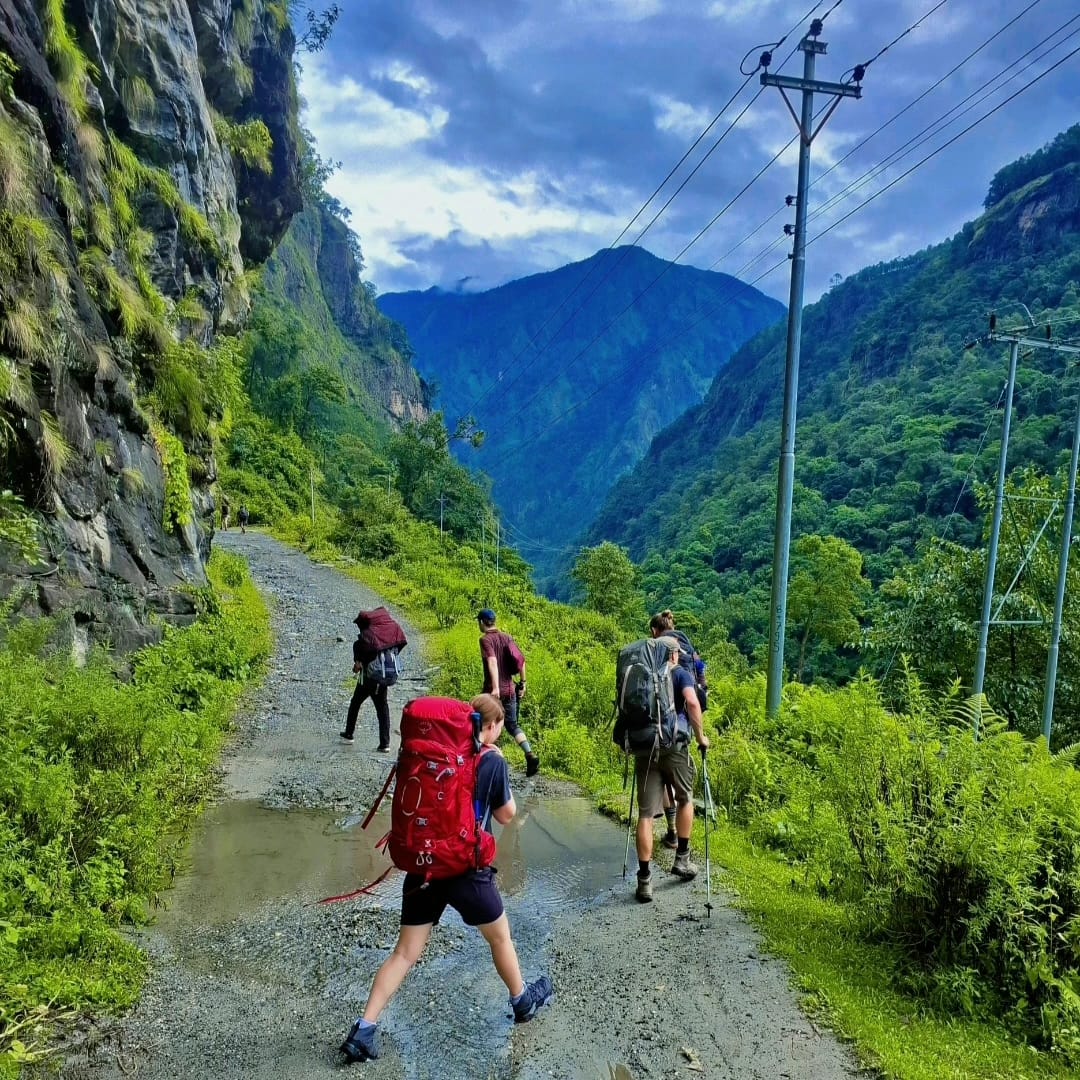
Spring transforms the Manaslu Circuit into a vibrant paradise, offering a unique and unforgettable trekking experience. Spring offers a unique and rewarding experience for trekking the Manaslu Circuit. The pleasant weather, vibrant landscapes, and stable trails make it an ideal time for seasoned trekkers and those seeking a challenging yet beautiful adventure.
Here’s what you can expect:
- Springtime warmth: The days become pleasantly warm, with temperatures ranging from 5-15°C (41-59°F) in the lower section and 0-10°C (32-50°F) in the mid-section.
- Crystal-clear skies: Prepare for breathtaking views as the winter clouds clear, revealing the majestic peaks in all their glory.
- Occasional rain showers: Be prepared for occasional rain showers, especially in late May.
- Blooming rhododendrons: The lower section of the trail explodes in a riot of color as rhododendrons bloom, creating a stunning spectacle.
- Lush green valleys: Witness the valleys come alive with vibrant green vegetation and cascading waterfalls.
- Snow-capped peaks: The higher sections still retain their snowy charm, offering a picturesque contrast to the blooming lower areas.
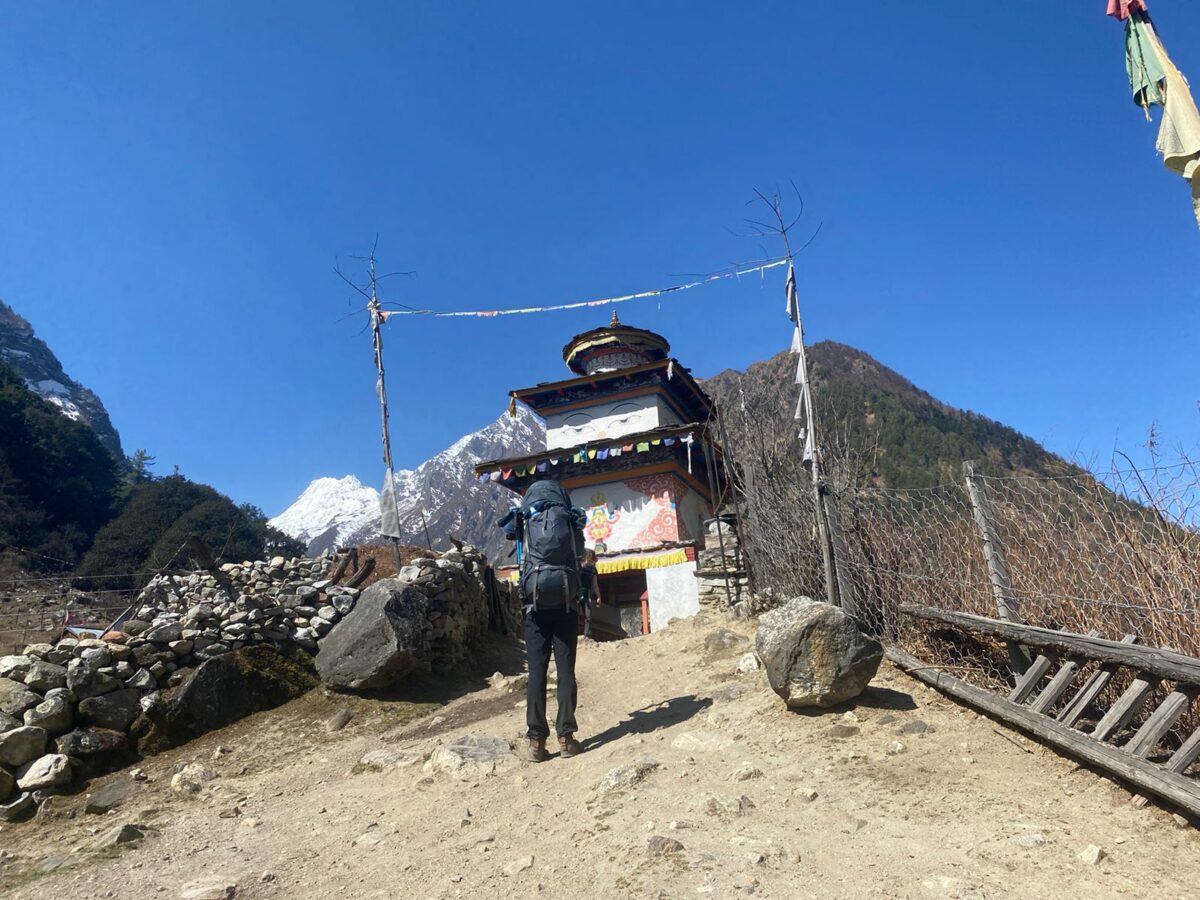
Level of Difficulty in Spring:
Snow gear is unnecessary as any snowfall will not last long, so it’s good for those without technical experience.
3. June to August
June to August is not a popular time to trek Manaslu Circuit Trek. Magical Nepal doesn’t operate the Manaslu Circuit Trek in Moonson(June to August). There are other wonderful treks that you can do in Monsoon in Nepal.
However, if you still want to do it, here are the things that you should consider.
- Slippery trails: Pack sturdy hiking boots and trekking poles for better grip.
- Potential landslides and river crossings: Research the route and be cautious in areas prone to landslides.
- Limited teahouse availability: Book accommodations in advance, especially during peak season.
- Unpredictable weather: Be prepared for sudden weather changes and adjust your plans accordingly.
Level of Difficulty in Monsoon:
A little more care has to be taken on slippery trails. June, July, and August are the months with the most rain. Expect a landslide in the trail.
How much rain can I expect on average during this time?
Expect frequent, heavy downpours, especially in July and August. Average rainfall in June-July is around 300mm, spiking to 500mm in August. Be prepared for wet days and sudden weather changes.
Will the Larke Pass be accessible, and what precautions should I take if it is partially snow-covered?
- Accessibility depends on snowfall and weather conditions. While partially snow-covered, it can still be crossed with proper gear and experience. Consider:
- Microspikes or crampons: If the snow is icy, these will provide essential traction.
- Warm layers and waterproof gear: Be prepared for cold, snow, windy conditions, and potential delays.
How slippery will the trails be due to the rain, and what footwear is recommended?
Trails become muddy and slippery, especially in lower sections. Invest in:
- Sturdy hiking boots with aggressive tread: Vibram Megagrip or similar soles offer excellent grip.
- Trekking poles: Provide additional stability and balance on uneven terrain.
- Waterproofing: Treat your boots and gaiters to repel water and mud.
Are there any areas on the route prone to landslides that I should be aware of?
Yes, the Lower section of the Manaslu Circuit Trek is prone to Landslide.
What happens if rivers become swollen due to heavy rains?
Be aware of:
- Bridge crossings: Use caution and check their stability before crossing.
- Alternative routes: Ask your guide if alternative paths are available to avoid swollen rivers.
- Emergency preparedness: Carry a waterproof communication device and know emergency contact information.
4. Late September to Mid December
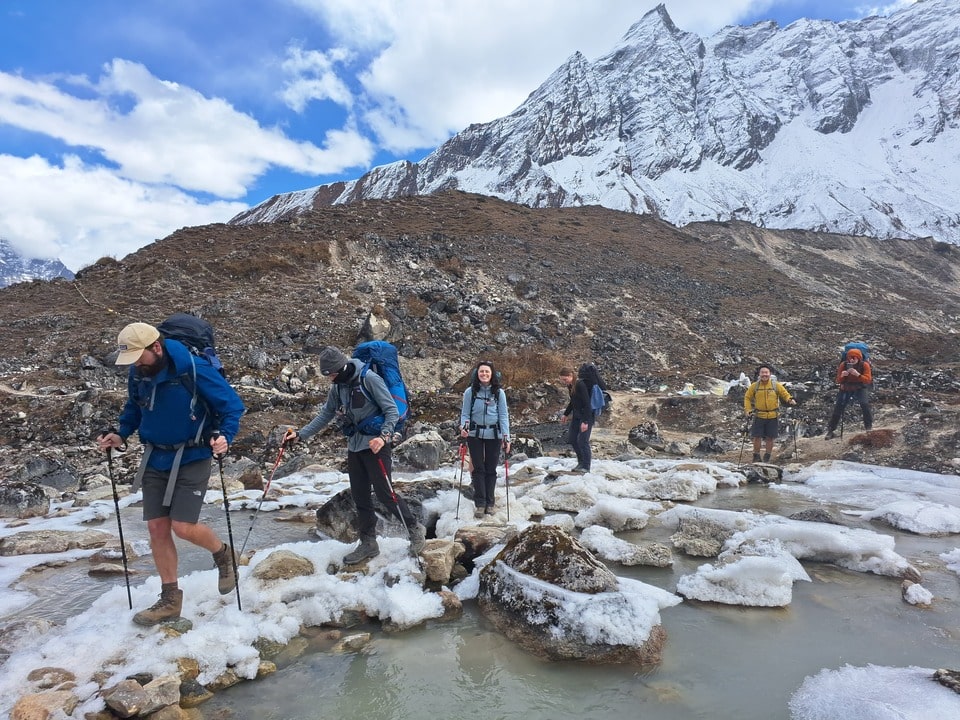
This is arguably the best time to trek in Manaslu – ten out of ten! The price of the restricted permits also goes up in the season.
The period from late September to mid-December marks a fascinating transition on the Manaslu Circuit. It bridges the gap between the lush monsoon season and the harsh winter, offering a unique blend of challenges and rewards for adventurous trekkers. Here’s what you can expect:
Weather:
- The gradual shift from monsoon to winter: Expect occasional rain showers in Early September, transitioning to drier and cooler temperatures in Late September, November, and December.
- Temperatures become progressively colder: Lower sections (800-2000m) range from 10-20°C (50-68°F) in September to 5-15°C (41-59°F) in December. Expect colder nights and freezing temperatures at higher altitudes in late December
- Snowfall: Light snowfall may begin above 3,000 meters in late November, increasing as December progresses.
Level of Difficulty in Late September to December:
Even for those who are not marathon runners, this is the ideal time to visit Manaslu!
But whichever time you choose to go, please pack accordingly. Check the general packing list for the Manaslu Circuit.
See Also,
